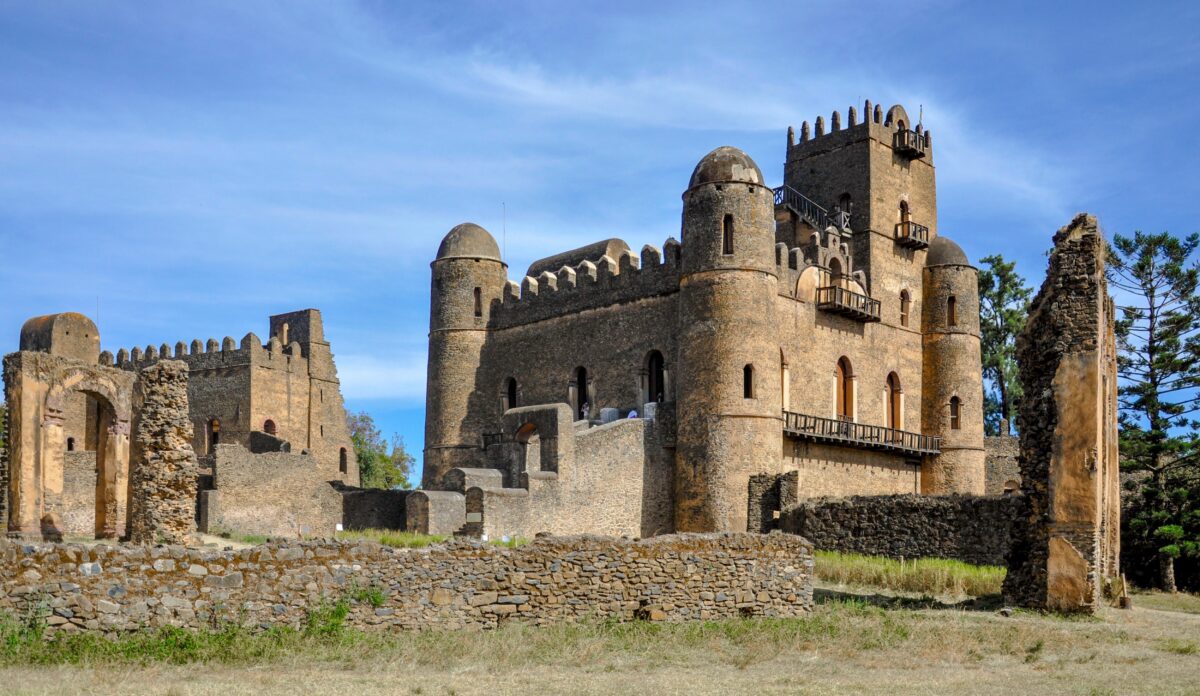Ethiopia is a land of ancient wonders, diverse landscapes, and a captivating history that stretches back millennia. Nestled in the Horn of Africa, this enchanting country offers many experiences, from majestic historical sites to breathtaking natural beauty. Let’s embark on a journey through Ethiopia, uncovering its unique geography, rich history, and diverse cultural heritage.
Geography and Climate
Ethiopia’s geography is very diverse. The country stretches over 1.1 million square kilometers, dominated by the towering highlands in the north and center, ringed by hot, arid lowlands. The Great Rift Valley, a geological marvel, bisects the country, punctuating the landscape with a series of lakes, hot springs, and volcanic formations. Ethiopia’s elevation ranges from the peak of Ras Dashen at over 4,500 meters above sea level to the Danakil Depression, lying 125 meters below sea level.
The climate in Ethiopia varies significantly due to its topographical range. The highlands experience a temperate, alpine climate with cool, wet summers and dry, chilly winters. In contrast, the lowland peripheries, especially the arid eastern regions of Afar and the Somali region, endure some of the hottest temperatures on the planet. The western rainforests receive a high amount of rainfall, creating a lush, humid environment. This geographical and climatic diversity makes Ethiopia a land of endless exploration and unique ecosystems.

History
Historical Dynasties of Ethiopia
The history of Ethiopia is marked by powerful kingdoms, ancient civilizations, and resilient people. The roots of Ethiopian history extend back to the time of the Aksumite Empire, one of the greatest kingdoms of the ancient world, which existed from around 100 AD to 940 AD. During this period, Ethiopia adopted Christianity, becoming one of the first nations in the world to do so. Read Also: Uncover Africa’s hidden treasures: Top 9 gems to visit
Following the decline of Aksum, Ethiopia went through a period known as the “Zagwe dynasty,” which lasted from the 10th to the 13th century. This era is recognized for its remarkable rock-hewn churches, most notably those found in Lalibela, which have since become a UNESCO World Heritage site.
The Solomonic dynasty, claiming descent from the biblical King Solomon, was the next to rule, starting in the 13th century. Over the centuries, the Solomonic rulers faced multiple challenges, including repeated invasions from the neighboring sultanate of Adal and, later, resistance against European colonial interests in the late 19th and early 20th centuries.
Modern Era and Achievements
In the 20th century, Ethiopia made global headlines with the Italian occupation under Mussolini from 1936 to 1941, which was fiercely resisted by the Ethiopian people and ultimately ended by a combined force of Ethiopian fighters and Allied forces. Following this, Emperor Haile Selassie, a defining figure in Ethiopian history, came to power and initiated a period of modernization and reform, albeit under an autocratic rule.
The late 20th century saw a period of severe political upheaval, with the Marxist Derg regime taking power in 1974 and ruling with an iron fist until 1991. This period, known as the “Red Terror,” was marked by widespread human rights abuses and famine.
Ethiopia has been working towards political stability and economic growth in the modern era. Despite challenges, the country has made significant strides in infrastructural development and poverty reduction. Today, Ethiopia is a prominent player in East Africa, boasting one of the fastest-growing economies in the region and playing a critical role in African diplomacy.

Population and Culture
Ethiopia boasts a population of over 115 million people, making it the second-most populous country in Africa. Its population is diverse, with more than 80 different ethnic groups, each contributing to the rich cultural heritage of the nation. The largest ethnic groups are the Oromo and the Amhara, who together make up more than half of the population.
Ethiopia’s culture is a vibrant mosaic of traditions, languages, and customs. Amharic and Oromo, the most widely spoken languages, contribute to the country’s linguistic diversity of over 80 languages. Despite this diversity, the official language, used in government, education, and the media, is Amharic.
The Ethiopian traditions, which date back to the 1st century AD, are deeply rooted in its Christian Orthodox Church. The church has played a significant role in shaping the country’s distinctive art, architecture, and music. The Ethiopian calendar, which is roughly seven years behind the Gregorian calendar, further highlights the unique cultural identity of Ethiopia. Read Also: African countries the US cautions you against visiting in 2023
Ethiopian society is still largely agrarian, with a significant number of its population living in rural areas. However, urban areas are rapidly expanding, and cities like Addis Ababa and Dire Dawa reflect a blend of traditional and modern lifestyles. Despite the challenges of poverty and infrastructural issues, the Ethiopian people exhibit a strong sense of community and resilience, reflecting their indomitable spirit.

Food and Cuisine
Ethiopian cuisine offers different flavors, textures, and aromas that reflect the country’s diverse cultural heritage. At the heart of Ethiopian cuisine is the sourdough flatbread known as Injera, a staple food traditionally made from teff flour. Injera serves as both a dish and an eating utensil, with other foods often served on a large piece of it.
Dishes are typically spicy, with the berbere spice mix being a key ingredient in many recipes. Doro wat, a spicy chicken stew, is one of the most famous dishes and is often served on special occasions. Kitfo, a dish made from raw minced beef mixed with chili powder and clarified butter, is also a favorite among Ethiopians. For vegans and vegetarians, Ethiopia offers dishes like Shiro (a thick stew made from powdered chickpeas or broad bean meal) and various vegetable and lentil stews cooked with different spices.
Ethiopian cuisine is also unique in that the country has many fasting days, where most Ethiopians abstain from animal products, leading to a wide array of vegetarian and vegan dishes. Traditional Ethiopian beverages include Tej (honey wine), Tella (homemade beer), and a coffee ceremony that involves roasting and grinding coffee beans and brewing coffee in a traditional manner.

Main Attractions and Tourism in Ethiopia
Tourism in Ethiopia offers a blend of history, culture, and natural beauty. The country’s numerous historical sites draw visitors from around the world. The rock-hewn churches of Lalibela, often referred to as the ‘Eighth Wonder of the World,’ are a UNESCO World Heritage Site. Aksum, the ancient capital of the Aksumite Empire, is home to towering obelisks, ancient tombs, and archaeological sites.
Ethiopia’s stunning natural landscapes also attract a multitude of tourists. The Simien Mountains National Park offers breathtaking views and is home to unique wildlife, including the Ethiopian wolf and the Gelada baboon. The Danakil Depression, with its otherworldly landscapes of sulfur springs and salt lakes, presents a challenging yet rewarding experience for adventurous travelers.
Moreover, the cultural diversity of Ethiopia provides an enriching experience. Visiting the tribes of the Omo Valley, exploring the unique walled city of Harar, or witnessing the colorful Christian Orthodox festivals are just a few examples of the immersive cultural experiences that Ethiopia offers.
The Ethiopian government has been making concerted efforts to promote tourism, with infrastructure enhancements and promoting sustainable and community-based tourism initiatives. With its array of historical sites, diverse cultures, and stunning landscapes, Ethiopia offers a unique and enriching experience for travelers seeking to explore the road less traveled.

Economy and Industries: Building a Bright Future
The agricultural sector contributes about 40% to the Ethiopian GDP, defining the country’s economic landscape. This sector predominantly includes small-scale subsistence farming, with coffee being the largest foreign exchange earner. Despite its dominance, agriculture remains vulnerable to climate change and inconsistent rainfall patterns, a challenge that Ethiopia is actively working to overcome by investing in irrigation projects and climate-resilient practices.
In recent years, Ethiopia has made significant strides in diversifying its economy. The manufacturing and industrial sectors have witnessed considerable growth, particularly in the areas of textile, garment, and leather production. The government’s commitment to building industrial parks and competitive labor costs has attracted foreign investment and boosted the country’s export revenues.
Additionally, Ethiopia’s service sector, including tourism, telecommunications, and banking, has also expanded and played an increasingly important role in the economy. The Ethiopian government continues to execute liberalization measures to attract foreign investment into these sectors. Read Also: Tanzania’s Efforts to Build Climate Resilience
The construction industry has experienced a boom, largely driven by public investments in infrastructure, housing, and commercial buildings. Furthermore, the Ethiopian government is pushing for development in the energy sector, particularly in renewable energy, establishing the Grand Ethiopian Renaissance Dam as the future leading source of electricity in Africa.
Bottom Line
Ethiopia has made significant strides in recent years, focusing on sustainable development, technological innovation, and poverty reduction. The government’s commitment to infrastructure projects, renewable energy initiatives, and the development of industrial parks reflects its vision for a prosperous and inclusive future.
“The best of humanity is a farmer, and the best type of food is fruit. Read more” – Ethiopian Proverb



